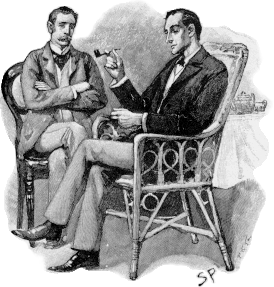Sherlock Holmes Museum
 The exterior of the Sherlock Holmes Museum and doorway marked as 221B | |
 Location within central London | |
| Established | 1990 |
|---|---|
| Location |
Baker Street London, NW1 United Kingdom |
| Coordinates | 51°31′25″N 0°09′31″W / 51.5237°N 0.1585°WCoordinates: 51°31′25″N 0°09′31″W / 51.5237°N 0.1585°W |
| Public transit access |
|
| Website |
www |
The Sherlock Holmes Museum is a privately run museum in London, England, dedicated to the famous fictional detective Sherlock Holmes. It opened in 1990 and is situated in Baker Street, bearing the number 221B by permission of the City of Westminster,[1] although it lies between numbers 237 and 241, near the north end of Baker Street in central London close to Regent's Park.[2][3]
The Georgian town house which the museum occupies as "221B Baker Street" was formerly used as a boarding house from 1860 to 1936, and covers the period of 1881 to 1904 when Sherlock Holmes and Doctor Watson were reported to have resided there as tenants of Mrs Hudson. The museum is run by the Sherlock Holmes Society of England, a non-profit organisation.
Numbering dispute

The address 221B was the subject of a protracted dispute between the museum and the nearby Abbey National building. Since the 1930s, the Royal Mail had been delivering mail addressed to Sherlock Holmes to the Abbey National Bank, and they had employed a special secretary to deal with such correspondence. The museum went through several appeals for such mail to be delivered to it, on the grounds that it was the most appropriate organisation to respond to the mail, rather than the bank whose primary business was to lend money out on interest. Although these initiatives were all unsuccessful, the issue was finally resolved in 2002 when the Abbey National vacated its headquarters after seventy years, and the mail is currently delivered to the museum.
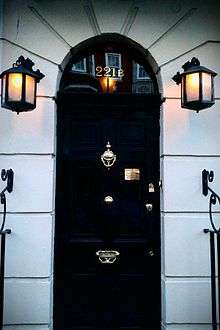
Family objections
Jean Conan Doyle made clear her lack of enthusiasm for the museum when she was asked about it. She was very much against the idea of suggesting that her father's creation was a real person and knew that the presence of the museum would reinforce the idea in the minds of many that Holmes had really existed.[4] This idea was strengthened further by the presence of a commemorative blue plaque on the outside that states the years of Holmes's supposed residency. Though the plaque is similar in design to those erected by English Heritage as part of the London-wide plaque scheme, it is not a part of that scheme, as their selection criteria rule out the commemoration of entirely fictional characters.[5]
The Museum did offer Dame Jean the opportunity to create a room in the museum dedicated to her father, but this offer was refused, and since then the last remaining possessions of Sir Arthur Conan Doyle have been sold off at auction.
- Interiors
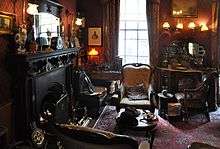 Sherlock Holmes "Sitting Room"
Sherlock Holmes "Sitting Room"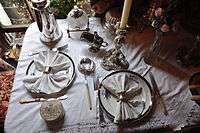 The table set in "Sherlock Holmes's Room"
The table set in "Sherlock Holmes's Room"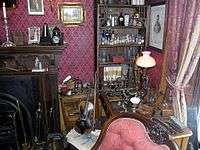 Sherlock's laboratory
Sherlock's laboratory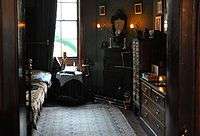 "Dr Watson's Room"
"Dr Watson's Room" The typewriter at the end time of the 19th century
The typewriter at the end time of the 19th century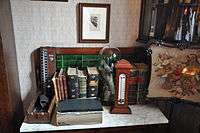 "Dr Watson's Room", books
"Dr Watson's Room", books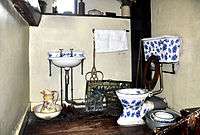 Bathroom.
Bathroom.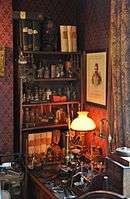 Sherlock Holmes Museum, Baker Street,"The Study",
Sherlock Holmes Museum, Baker Street,"The Study", Cyclist sculpture, put on display to illustrate the short story "The Adventure of the Solitary Cyclist"
Cyclist sculpture, put on display to illustrate the short story "The Adventure of the Solitary Cyclist" "Mrs Hudson's Room", fireplace
"Mrs Hudson's Room", fireplace "Dr Watson's Room", washstand
"Dr Watson's Room", washstand
References
- ↑ The Sherlock Holmes Museum – On This Very Spot
- ↑ Thomas Bruce Wheeler (2003). Finding Sherlock's London: Travel Guide to Over 200 Sites in London. iUniverse. ISBN 0-595-28114-1.
- ↑ "Sherlock Holmes 101". Washington Post. 11 January 2004.
- ↑ Duncan, Alistair (2009). Close to Holmes: A Look at the Connections Between Historical London, Sherlock Holmes and Sir Arthur Conan Doyle. London: MX Publishing. ISBN 1-904312-50-0.
- ↑ Celebrating People & Place, Blue Plaque Guidance, English Heritage, p42
